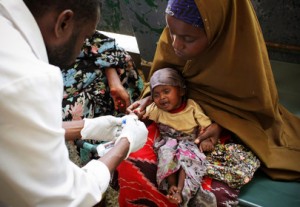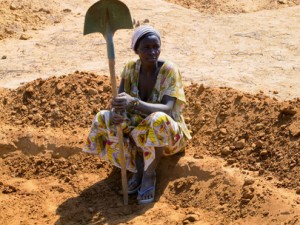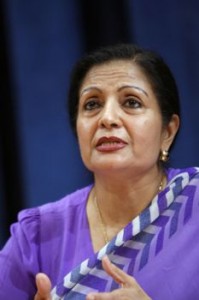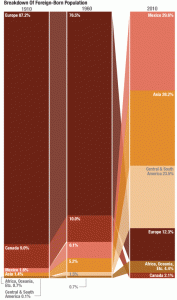As always with rich reports like these, there is too much valuable info to squeeze into one article, so I’m making use of this space to draw [...]]]>

UN Photo/Stuart Price
Some may have seen my most recent article providing some highlights of a new UNICEF report on the global progress in reducing child mortality since 1990.
As always with rich reports like these, there is too much valuable info to squeeze into one article, so I’m making use of this space to draw attention to some more statistics that I think are worth mentioning.
For example:
:: Half of all under-five deaths occur in only five countries.
:: These countries are India, DRC, Nigeria, Pakistan and China.
:: 40 percent of all children dying under the age of five die within the first 28 days after birth.
:: UNICEF estimates that by 2050 one in three children will be born in sub-Saharan Africa.
Now, onto some positive news. Here are 12 former high-mortality countries that have made strides in reducing under-five mortality and are close to achieving Millennium Development Goal 4 by 2015.
Percentages are reduction:
Laos: 72 percent (MDG 4 achieved)
Timor Leste: 70 percent (MDG 4 achieved)
Liberia: 68 percent (MDG 4 achieved)
Bangladesh: 67 percent (MDG 4 achieved)
Rwanda: 65 percent
Nepal: 64 percent
Malawi: 64 percent
Cambodia: 64 percent
Madagascar: 62 percent
Bhutan: 61 percent
Ethiopia: 61 percent
Niger: 60 percent
]]>Lubetkin’s participation high-lights the importance of the press in creating peace culture through its role as both documenters and public opinion makers.
Realising that importance, IPS has run a number of [...]]]>

Young students in traditional dress waive their national flags during the observance of the International Day of Peace at United Nations headquarters in 2007 | UN Photo/Paulo Filgueiras
IPS’ General Director Mario Lubetkin is about to speak at the U.N. High-level Forum on a Culture of Peace in New York today.
Lubetkin’s participation high-lights the importance of the press in creating peace culture through its role as both documenters and public opinion makers.
Realising that importance, IPS has run a number of stories focusing on peace building at both the community and political level in the weeks leading up to the Forum, including two yesterday that take a closer look at our own role as journalists.
Constanza Vieira’s story on the state of the press in Colombia is an interesting one, as it’s a tale of caution on how long-term national conflict and close ties between the press and government can severely influence the tone of a national media establishment and limit the ability of critical journalists to counter ingrained hard-line narratives.
“One problem was that the media in [Colombia] had turned ‘peace’ itself into a dirty word”, she said, explaining how a shift is only gradually happening through the blogosphere in Colombia.
Instead of “spreading the poison,” journalists need to be trained to fulfill their obligation to provide context that helps “feelings turn into logic,” according to a Colombian journalist in Vieira’s story.
In an interview with IPS’ Rousbeh Legatis, Tarja Turtia, programme specialist at UNESCO’s Division for Freedom of Expression, affirms the importance of the media and particularly blogs in post-conflict states in “starting debates that could not be initiated openly before.”
She also stressed the importance of strong community media in countries like Sierra Leone, in preventing conflict by providing accurate and timely information to remote areas via radio, which UNESCO supports through its International Programme for the Development of Communication.
Since media pluralism is widely acknowledged as part of peace building, I should also mention the importance of self-representation in changing encrusted narrative and tip a hat organizations like Viva Favela in Brazil, who have created a platform for residents of urban slums across the country to tell their own stories as alternative to the often negative media representation that “moradores” experience.
Like Viva Favela, in the U.S. local public access T.V. channels like Manhattan Neighborhood Network here in New York actively built dialogues in communities and empower residents to become media makers and instigators of positive change in their neighborhoods.
Providing a platform for “slow” stories on peaceful resolution of conflicts and acts of community building in today’s rather cynical age of “if it bleeds it leads” has almost become an act of defiance.
But then, peaceful defiance has always been an essential part of opposing war.
]]>Not only is women’s personal development hampered by disproportionate water-collection duties, their [...]]]>
Not only is women’s personal development hampered by disproportionate water-collection duties, their limited access to productive resources (because of gender discrimination), including irrigation, also causes lower food production overall and thus hunger in developing countries.
You want a side of statistic with that? No problem.
Investing in women-owned agriculture businesses could bring the number of the world’s hungry down by 100 to 150 million people.
Sit with that number for a second and then continue reading.
As Thalif Deen recently reported (reiterated yesterday by Lakshmi Puri, deputy executive director of UN Women) women spend more than 200 million hours per day collecting water.
That’s 40 billion hours per year.
71 percent of the water collection burden falls on women and girls.
We all know the popular media image of women water bearers, but the development loss that occurs for women in that act is rarely quantified.
Women’s disproportionate burden of fetching water limits their personal development, productive capacity and community engagement, including school attendance, market activity and their involvement in local leadership and decision-making.This also has negative effects on building and maintaining peace.
Progress has been made on improving secure water supplies in developing countries and reducing walking distances, but “783 million people still remain without access to an improved source of drinking water,” according to Puri.
She emphasised that “Creating a water- and food-secure world requires putting women and girls at the centre of water and food related policies, actions and financing.”
Rather than seeing women as “beneficiaries of greater water and food security,” they ought to be seen as contributors to greater progress.
Puri lists four urgent actions to “unleash their potential” [emphasis and formatting mine]:
1. Women need to be recognised as water managers, farmers and irrigators, who contribute to ensuring sustainable food production and consumption and to safeguarding the environment.
This must be done in laws, policies and through social awareness programmes in communities.
2. Governments and other partners need to ensure that women are empowered along the water and food supply chain, so that their food production and water management roles are supported.
Improvements in infrastructure services— especially water and electricity—can help free up women’s time spent on domestic and care work. […]
3. We need to address the multifaceted gender discriminations in accessing and controlling productive resources.
Women must be provided with technical training on water management, irrigation, rainwater harvesting, and rain-fed agriculture.
4. Women must be recognised as decision-makers in water governance.
This involves reducing membership fees and broadening the mandate of irrigation schemes to acknowledge and include multiple water users.
]]>
This begs the question: what exactly is it?
As my lead suggests, it’s not the first [...]]]>
 This week, as minds here in New York and elsewhere are inevitably drawn back to 9/11 and its aftermath, the U.N. General Assembly (GA) will once again discuss the worldwide promoting a Culture of Peace.
This week, as minds here in New York and elsewhere are inevitably drawn back to 9/11 and its aftermath, the U.N. General Assembly (GA) will once again discuss the worldwide promoting a Culture of Peace.
This begs the question: what exactly is it?
As my lead suggests, it’s not the first time the topic has passed our U.N. news desk.
Spearheaded by UNESCO, United Nations Educational, Scientific and Cultural Organization, 2000 became the U.N. Year for a Culture of Peace. For those who missed it, the GA doubled down on the concept a year later by declaring a Decade of the Culture of Peace (2001-2010) in which it took a stab at involving civil society in creating a global movement for peace culture.
75 million people signed a 2000 Manifesto pledging their support – Meanwhile, a quick survey among my friends revealed that, unfortunately, none knew of it.
“Peace is the absence of war” continues to be an evergreen. But how exactly do you create a culture in which war is absent? What is a Culture of Peace?
In a 1999 resolution and Programme of Action prepared by UNESCO, the GA agreed on eight elements of a Culture of Peace.
Here’s a little overview, drawn from the ’99 resolution and various works of David Adams, former Director of the UNESCO Unit for the Year of a Culture of Peace and an expert on the brain mechanism of aggression.
1. Education for Peace
Since warfare is a learned behaviour, according to Adams, a key component to building a Culture of Peace is a shift from an authoritarian and war-centric educational tradition to a participatory education on values and modes of behaviour that allow youth to resolve disputes non-violently and with respect for human dignity.
This education ought to take place not only in schools, but include informal education taking place through the family and the media, as well as non-governmental and community organizations.
2. Understanding, tolerance and solidarity
The act of “othering” people and designating an enemy is a key component to warfare and detrimental to a Culture of Peace.
Instead, the U.N. and social institutions at all levels ought to foster dialogue and actions that build mutual understanding, tolerance and solidarity.
3. Democratic participation
Hierarchical structures and authoritarianism that are at the centre of warfare ought to be replaced with people’s democratic involvement at all levels of decision-making affecting their lives.
In addition to stronger education on democratic principles, the resolution mentions capacity-building of public officials to strengthen institutions and processes that promote democracy.
4. Free flow of information and knowledge
A strong and free media is essential to documenting and promoting peace culture, while networks are essential social infrastructures.
Propaganda and secrecy, on the other hand, are essential to maintaining public approval for warfare. A free flow of information is thus essential to building a culture of peace in which an informed population is able to exercise its democratic rights to voice disapproval of acts of aggression.
5. Equality of women and men
Male domination is a central part of the culture of war, according to Adams, not because of a genetic disposition to warfare, but because of the age-old initiation of men into war and women’s systematic exclusion from it.
A transformation to a Culture of Peace therefore requires power sharing and the equal participation of women in decision-making.
6. Sustainable human development for all
Building secure livelihoods and the ability to lead healthy productive lives are key to building and maintaining peace.
Debt relief for developing countries, post-conflict reconciliation processes, and a special focus on the needs of women and children in developing strategies are listed as state-based contributions to a Culture of Peace.
7. Disarmament
While this may seem like a no-brainer, disarmament was actually among the last two items to be added to the action agenda, which originally only had six points.
It finally made it in under the header “Actions to promote international peace and security”, with complete disarmament as the top action item.
8. Respect for human rights
Respect for human rights as an essential component of peace culture encompasses many of the above points and should need little explanation.
Among the action items, the U.N. declaration sought the full implementation of the 1993 Vienna Declaration and the development national programmes and institutions to protect human rights.
]]>
In light of the ongoing immigration debate [...]]]>
 For those who missed it, last week U.S. President Obama’s new “deferred action” immigration program went into effect, halting the immediate deportation of young undocumented immigrants and allowing them to apply for work permits instead – which they did by the thousands.
For those who missed it, last week U.S. President Obama’s new “deferred action” immigration program went into effect, halting the immediate deportation of young undocumented immigrants and allowing them to apply for work permits instead – which they did by the thousands.
In light of the ongoing immigration debate – which is likely to flare up as the presidential race heats up – I was intrigued when I stumbled on these graphs that NPR’s Lam Thuy Vo put together for Planet Money this week, based on the latest U.S. Census data.
Aptly called “100 years of Immigration in two graphs” the illustrations highlight that the percentage of foreign-born people residing in the U.S. is actually roughly the same as a century ago – it’s the origin of that foreign-born population, however, that has drastically changed and become more diverse.
Where a century ago 13.4 percent of people living in the U.S. were foreign born and 87.2 percent of those were European, today, about 12.8 percent are foreign born, but only 12.3 percent of that group are European. Instead, Latin America and Asia take the immigration crown, with Mexico being country-of-origin numero uno.
With the public debate in the U.S. often focussing on how the total number of current immigrants breaks historic records, preferably accompanied by dramatic data graphs that start in the immigration-poor 1960s, it’s nice to see NPR’s clear data visualisation providing a larger historical and national context.
On a side note, last month I wrote about Mexican-born Librada Paz receiving the Rober F. Kennedy Award for her struggle for farmworkers’ rights, hers being a life story not unlike that of many undocumented immigrants now benefiting from Obama’s decree.
For more on the unseen effects of the U.S. deportation policies on families, read IPS’ Zoha Ashad’s piece this week.
]]>In her opening statement, Amos expressed concern that the humanitarian situation has visibly worsened since her last visit in March and cited government figures of 1.2 million people currently seeking shelter [...]]]>

Credit: U.N. Photo/ JC McIlwaine
Valerie Amos, U.N. Under-Secretary-General for Humanitarian Affairs and Emergency Relief Coordinator, briefed the press yesterday on her recent trip to Syria and Lebanon.
In her opening statement, Amos expressed concern that the humanitarian situation has visibly worsened since her last visit in March and cited government figures of 1.2 million people currently seeking shelter in public buildings across Syria.
So far, only about half of the funding appeal for the crisis has been met, the Under-Secretary-General said in response to questions by gathered press, with the majority of funds going to food aid.
She appealed for international partners “to contribute more generously.”
The World Food Programme and Syrian Arab Red Crescent together were able to feed 820,000 people last months, according to Amos, but the U.N. is “falling short” she stressed, in light of an estimate 2.5 million people in need.
The most urgent and growing needs are for health care, shelter, food, water and sanitation. There are serious public health issues in the school buildings that are being used as shelters. There will also be disruption to the education of thousands of Syrian children when the academic year begins in September, unless other solutions are found in terms of housing internally displaced people.
Amos further projects major health impacts because crucial life-saving medicines are no longer available in Syria.
Since the ability to distribute food depends on the local security situation, food distribution has also been “patchy,” she said.
We face problems with access to people in need, particularly where there is intense and ongoing fighting, but funding is also holding us back. If we had more resources, we could reach more people, especially as we have established solid partnerships with local NGOs and with the Syrian Arab Red Crescent.
In response to questions regarding a proposal to establish “safe-zones” across the country, the Under-Secretary-General said that a number of obstacles stand in the way, including the fact that Syria opposes the idea and that policing such zones would be impossible without a Security Council resolution. There currently is “no appetite in the Security Council” for such a resolution, Amos said.
Amos’ visit followed the resignation of Kofi Annan, Joint Special Envoy of the United Nations and the League of Arab States for Syria, earlier this month after the Security Council reached a dead end on Syria .
]]>As I reported last month, [...]]]>

UN Photo/WFP/Phil Behan
As Beyonce’s video celebrating World Humanitarian Day continues to make its rounds through the internet, humanitarian workers on the ground in the drought-affected Sahel arguably have bigger fish to fry as they try to stave off deteriorating conditions in Niger and Mali amidst staggering shortages in relief funding.
As I reported last month, the United Nations Office for the Coordination of Humanitarian Affairs (OCHA) recently adjusted its needs projections for 2012 upward in light of what can be called a foreseeable escalation of the food crisis in the Sahel that started last fall.
Now it looks like cholera and locusts are further foiling already underfunded relief efforts across West Africa.
With four months left to the year, only 51 percent of the funding goal for the region has been met according to latest numbers by the U.N.’s Financial Tracking Service.
So far, an estimated 19 million people in the region are in dire need of assistance, many of whom were expected to rely on emergency food aid as primary means of sustenance by August.
In a special humanitarian bulletin on the Sahel crisis published last week, OCHA now warns of a developing locust infestation that could affect another 50 million people and diminish yields in the upcoming October harvest.
“Desert locust infestation remains dangerous as more egg-laying and hatching are expected in the coming weeks. Agricultural crop production, food and nutrition security, and the livelihood of some 50 million people in Chad, Mali and Niger are currently at risk, according to the FAO. This threat is the most serious since 2005.
Ground teams in Niger have treated 1,200 hectares against the pest since 5 June but ground surveys need to be scaled up to determine the scale and extent of current breeding, especially in those areas where rains have recently fallen.”
Still, rains are badly needed, as an early end to the current rainy season would further affect the upcoming harvest and increase food prices, according to a special report by the Famine Early Warning System Network.
As if that weren’t enough to juggle, cholera is now becoming an increasing worry in Niger, where refugee camps are a potential hotbed for the disease that could affect neighbouring countries along the Niger river, such as Mali, Nigeria and Benin.
About 52.000 people have fled political upheaval in Mali for Niger where 394,000 children under five will need treatment for severe acute malnutrition this year, according to UNICEF, which warns that malnutrition increases the chances of cholera outbreaks.
Nigeria has seen three times the number of cholera cases this year that it registered in 2011, according to Innocent Nzeyimana, the World Health Organization (WHO) Emergencies Manager in Niger in a recent OCHA story. “At this rate, we should be prepared for at least 9,000 cases by December.”
More from Nzeyimana:
“With high levels of water contamination and inadequate sanitation, our area is so prone to cholera. We’ve had cases in 2010 and 2011, but this time it is really getting serious.”
“In a closed environment like a camp, the spread is very fast and we may end up dealing far beyond the 9,000 projected cases. We don’t want that to happen.”
Prevention and treatment of cholera, meanwhile remains underfunded across the Sahel, with only 21 percent of the projected 53 million dollars needed for such programmes covered so far. In Niger only 30 percent of the roughly 8-million-dollar projected sanitation need has been met.
Organizations increasing their appeals
Last week, U.K.-based NGO Christian Aid doubled down on its aid appeal amidst reports by the World Food Programme (WFP) that without increased international support an estimated quarter million people fleeing political instability in Mali for neighbouring Niger, Mauritania and Burkina Faso, will go hungry in just weeks.
WFP is appealing for urgent contributions of 115 million dollars to address pipeline shortfalls for the next three months, according to last week’s OCHA bulletin, as the region is going through its lean season.
As the region awaits the fall harvest and food prices soar, many families continue to sell off their life stock, thus further diminishing their future capacity to foresee in their own livelihoods.
The United Nations Food and Agricultural Organization (FAO), which aims to build farmer’s resilience to future crises has seen less than 25 percent of its 112-million-dollar appeal met, threatening FAO’s ability to support preparations for the next food production campaign from October to December.
FAO is appealing for 10 million dollars to tackle the locust situation. So far France has contributed 550,000 dollars, and another 2.8 million has been pledged bi-laterally.
Last month, British NGO Development Initiatives released a comprehensive report on Humanitarian Aid that projected record shortfalls for 2012. Among other conclusions, the report showed a disproportionate funding for the 2010 mega-disasters in Haiti and Pakistan that syphoned away funds from other countries, including crisis prevention in countries in the now heavily affected Sahel region.
A quote from an OCHA rep in a recent AP article sums it up nicely, I think:
“Pictures of starving goats do not attract aid in the same way as images of dying children.”
Well, folks, we’re getting there.
]]>
A number of these companies, like Dyncorp International, have been [...]]]>
A number of these companies, like Dyncorp International, have been linked to a plethora of alleged human rights violations, sparking various international efforts to regulate the industry, as I reported earlier this week.
The report, published by the New York- based Global Policy Forum (GPF), recently prompted a direct responses from Greg Starr, head of the U.N. Department of Safety and Security (DSS), who wrote a letter to GFP, which the organisation published on its website this week, along with its response to the letter.
Two of the PMSCs mentioned in the report, DynCorp and G4S, (the latter having been the security provider for this year’s London Olympics) also issued statements challenging the negative portrail of PMSCs by GPF.
GPF raised concerns about post-9/11 “bunkerisation” within the U.N. – an increasing use of private security, partially fueled by involving firms directly in assessing risks and needs — as well as a lack of guidelines within the U.N. to vet contracts.
In his response to the report, Starr stated:
The fact is that there are unfortunately places in the world today where relying on the principle of acceptance does not provide the security necessary to continue operations. “Hard” security measures, which the report goes to great lengths to prove counterproductive in all instances, are actually necessary and appropriate at times.
He added that:
The overwhelming majority of contracted services for guards by the United Nations are related to residential or facility protection.
Starr admitted that “Our existing policy guidance on armed security contractors is dated, and there was a desire to address any concerns within the United Nations as to whether security companies used had requisite levels of oversight and management.” DSS has been spearheading a draft policy, he said, that “proposes a decision making framework and high standards for management accountability” for the use of PMSCs and “goes a very long way to ensuring that specific criteria was established so that the United Nations is neither tainted, impacted nor otherwise compromised by the use of these companies,” according to Starr.
GFP responded by saying it was unaware of serious policy guidance, “dated or of more recent origin” that has shaped U.N. practice regarding PMSCs and that the proposed new guidelines have not been approved and put into practice after two years of discussion.
Starr further criticised GPF for using “incomplete” data in its report.
GPF responded by quoting from an email Starr had sent to the report’s author, Lou Pingeot, during her research phase, in which the DSS chief himself declared it was impossible to know how much the U.N. spends on private security contractors annually and that he would “not hazard an estimate on an overall number.”
This lack of available statistics brings into question the ability of DSS to oversee system-wide security issues, according to GFP who in its response to Starr this week urged the DSS chief to publish annual statistical surveys of PMSC contracts.
Last month’s report, titled “Dangerous Partnership: Private Military Companies and the UN” used available U.N. procurement data to show an upward trend in the U.N.’s use of PMSCs, with a rise of 250 percent in field missions from 2006 to 2011.
While Starr emphasises the importance of PMSCs in guaranteeing security of U.N. personnel annual reports by the Secretary General on the Safety and Security of UN Personnel have failed to mention the use of private contractors and to what extend they are hired.
GPF holds that DSS is “failing in its responsibility to inform member states and the public about the UN’s security policy” and urges the U.N. to undertake a broad-ranging inquiry.
We would urge DSS to adopt a more forthcoming approach, incorporating reference to PMSCS in all reports where appropriate. Indeed, we believe that the United Nations should ask a blue ribbon panel of experts to prepare a broad-ranging inquiry into the costs, governance implications, policy impact and reputational issues posed by PMSCS. This would offer member states and the public a much-needed appraisal of these topics and lay the basis for a thorough-going review by the General Assembly.
“The U.N. [contracting system] has always been a crapshoot and it’s something we’d like to see professionalised,” Doug Brooks, President of the Washington D.C.-based PMSC trade association International Security Operations Association (ISOA), told me earlier this month.
Brooks particularly pointed to the U.N.’s penchant for late payments, which tilts the playing field in favour of large companies that can support operations while waiting up to a year for payment. “Big companies who work for the U.N. call it leaning forward — If you are a small business, there is no way you can do that.”
In addition to calls for the U.N. to improve its policies on hiring PMSCs, there are a number of international efforts underway to regulate the industry more broadly and make protection of human rights an integral part of its operations.
“I think that a key challenge for the industry is that it’s behind other industries in learning about how to integrate human rights into its strategies and operations,” James Cockayne, and expert on International Criminal Justice who has been involved in PMSC legislation efforts, told me. “It’s time that this industry caught up.”
]]>
